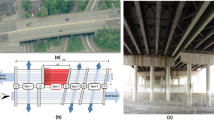Abstract
Structural damping is an important parameter in system identification and assessment of structural systems. Due to its variable nature, especially in highway bridges, precise estimation of damping poses challenges both from the computational point of views as well as complexity of operations. Survey of technical literature indicates that several methodologies have been developed over the past few decades for the determination of structural damping parameters. The present study determines damping in an operational highway bridge using two approaches, namely, the decay of motion direct measurement and the natural excitation technique. A two-span concrete box girder bridge was instrumented with various types of fiber optic Bragg grating sensors. Series of live load tests were performed on the bridge using a calibrated truck. Estimated damping was implanted in a detailed finite element model of the bridge. Live load on the actual bridge was replicated on the finite element model and the calculated results correlated with measured data at site.





Similar content being viewed by others
References
Siu-Kui Au, Zhang Feng-Liang, To Ping (2012) Field observations on modal properties of two tall buildings under strong wind. J Wind Eng Ind Aerodyn 101:12
Kelly JM (1999) The role of damping in seismic isolation. Earthq Eng Struct Dyn 28(1):3–20
Huang MF, Chan CM, Lou WJ (2012) Optimal performance-based design of wind sensitive tall buildings considering uncertainties. Comput Struct 98–99:7–16
Wolf JP (1988) Soil-structure-interaction analysis in time domain. Prentice Hall, Englewood Cliffs
Sarpkaya TS (2010) Wave forces on offshore structures. Cambridge University Press, Cambridge
Ibrahim SR, Mikulcik EC (1977) A method for the direct identification of vibration parameters from the free response. Shock Vib Bull 47:183–198
Peeters B, De Roeck G (1999) Reference-based stochastic subspace identification for output only modal analysis. Mech Syst Sign Process 13(6):855–878
Caicedo JM (2011) Practical guidelines for the natural excitation technique (NExT) and the Eigen-system realization algorithm (ERA) for modal identification using ambient vibration. Exp Tech 35(4):52–58
Farrar CR, James GH III (1997) System identification from ambient vibration measurements on a bridge. J Sound Vib 205(1):1–18
Razak HA, Choi FC (2001) The effect of corrosion on the natural frequency and modal damping of reinforced concrete beams. Eng Struct 23(9):1126–1133
Swain AK, Billings SA (2001) Generalized frequency response function matrix for MIMO non-linear systems. Int J Control 74(8):829–844
Bendat JM, Piersol AG (2000) Random data: analysis and measurement procedures, 3rd edn. Wiley, Hoboken, NJ
Jaishi B, Ren WX (2005) Structural finite element model updating using ambient vibration test results. ASCE J Struct Eng 131(4):617–628
Chopra K (2000) Dynamics of structures: theory and application to earthquake engineering, 2nd edn. Prentice Hall, Englewood Cliffs, NJ
Bassam SA, Ansari F (2008) Post-seismic structural health monitoring of a column subjected to near source ground motions. J Intell Mater Syst Struct 19(10):1163–1172
Acknowledgments
This material is based upon work supported by the National Science Foundation under Grant No. 0730259.
Author information
Authors and Affiliations
Corresponding author
Rights and permissions
About this article
Cite this article
Zarafshan, A., Ansari, F. & Taylor, T. Field tests and verification of damping calculation methods for operating highway bridges. J Civil Struct Health Monit 4, 99–105 (2014). https://doi.org/10.1007/s13349-013-0067-y
Received:
Revised:
Accepted:
Published:
Issue Date:
DOI: https://doi.org/10.1007/s13349-013-0067-y




